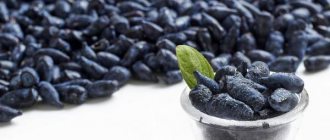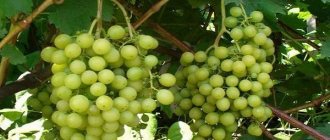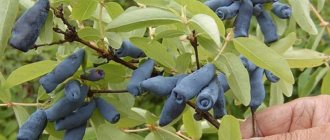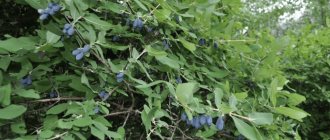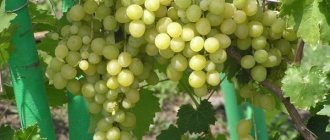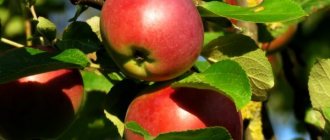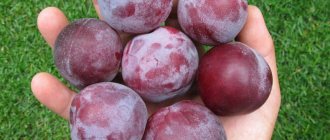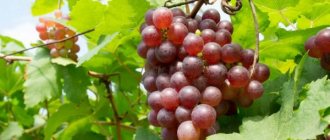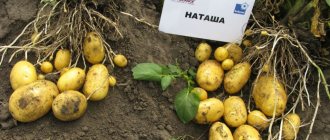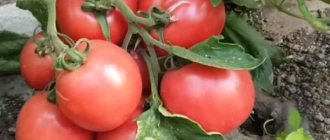The Nizhny Novgorod early honeysuckle variety is suitable for the middle zone due to its properties. The culture requires infrequent watering and fertilizing, and is more selective in its location of growth. Planted in a group of several pollinator varieties, it produces a good harvest.
The bushes of the variety are not tall, convenient for harvesting
Description of honeysuckle Nizhny Novgorod early
The dessert variety Nizhny Novgorod early bush is medium-sized, up to 1.4-1.7 m. A dense spherical crown is formed by erect, medium-leafed trunks. The leaf blades are medium-sized, elongated, lanceolate, dark green. The root system of honeysuckle is superficial, fibrous. Leave 1.6 m between planting holes for honeysuckle. It begins to bear fruit in the 3rd year after planting.
In Nizhny Novgorod early, the fruits begin to ripen by mid-June, when the skin becomes covered with a characteristic blue color. The size of the oval-elongated honeysuckle berries of the early ripening variety is 12-16 mm. Medium weight berries, from 80 to 120 mg. From the beginning of growth, the fruits are green, then the flesh and skin turn dark blue, with a waxy coating remaining on top. The fruits of Nizhny Novgorod early belong to the table variety and have a sweet and sour invigorating taste.
One bush of honeysuckle Nizhny Novgorod early gives 3-3.8 kg. The berries ripen one and a half months after flowering, depending on the geographical location - already at the end of the first or second ten days of June.
Table honeysuckle bushes at the age of 5-6 years produce more than 5 kg of berries with good care:
- timely watering;
- competent feeding;
- disease prevention.
When choosing varieties, gardeners note the advantages of honeysuckle Nizhny Novgorod early:
- medium sized fruits;
- pleasant taste of berries, in which there is no bitterness;
- early ripeness and friendly ripening;
- dry fruit separation;
- frost resistance of the shrub.
Thanks to these characteristics, sweet Nizhny Novgorod honeysuckle is grown in personal farmsteads and large agricultural enterprises. The disadvantages are the properties characteristic of most varieties of the crop: the fruits ripen very quickly, and if there is a delay in picking, the overripe berries fall off.
The fruit is harvested when the flesh and skin turn uniformly blue. In this stage of ripeness, the berries acquire their characteristic refreshing, sweet and sour taste. When collected, they are placed in small half-liter containers. Keeps in the refrigerator for two weeks.
The most valuable characteristics of plants of the Nizhny Novgorod Early variety are winter hardiness and immunity to spotting.
Advice! To prevent crop loss due to berry shedding, films or blankets are spread under the bushes before ripening.
Nizhny Novgorod early berries are small but tasty
Plant varieties
More often, honeysuckle, which has edible berries, is planted in gardens. Favorite varieties by Russians: Pavlovskaya, Borel, Blue Spindle, Amphora, Gzhelka, Vasyuganskaya, Gerda, Sinichka, Nymph Sineglazka, Blue Bird, Bochkarskaya, Leningrad Giant, Cinderella, Kamchadalka and Blueberry. If desired, you can easily find a detailed description and reviews of each of them. There are varieties of newer selection, but they can fail in a frosty winter, but these have already been tested over the years by several generations of gardeners. Varieties differ in the ripening period of the crop, the height of the bushes and the shape of the branches, and the taste of the berries.
short
- Gourmand is a compact bush, the yield is high, but the berries are not very large, weighing about 0.7 g. The fruits are without bitterness and are characterized by low shedding. The variety is suitable for hedges. Plant “Nymph” and “Nizhny Novgorod early” next to it for pollination.
- Omega is also a low-growing variety with a rounded crown, but the berries are larger and reach a weight of up to 1 g. It cannot boast of a high yield, but the berries practically do not fall off. The fruits are without bitterness, sweet and sour, the plant is planted as a hedge.
Medium height
- Nymph is a compact bush with an oval crown and dark green leaves. The berries are large, 3 cm each, and weigh up to 1.2 g; with careful care, each bush produces a harvest of 1.5 kg. The berries have a pleasant sweetish taste, slightly sour. Plant next to “Violet”, “Omega”, “Blue spindle” for pollination.
- Leningrad giant - the name speaks of both the place of selection and the size of the fruit. The starting material for breeding was the seeds of the Kamchatka endemic. The berries ripen early, can reach a size of up to 4 cm, but more often - 3 cm, have a dense skin, the yield of the bush reaches 3 kg. The peculiarity of the variety, in addition to the size of the berries, is their arrangement - in clusters, which speeds up the harvest. The fruit tastes without sourness or bitterness and does not fall off the bushes for a long time.
Planting and caring for honeysuckle Nizhny Novgorod early
Honeysuckle seedlings have a fibrous root; when purchased, the shoots should be elastic, not dry. 2-5 hours before planting, place the plant in a liquid clay mash so that the roots are saturated with water.
Landing dates
The Nizhny Novgorod early honeysuckle variety is recommended to be planted from the first warm days of spring in March or April. The plant's buds begin to swell very early, so the bush is moved almost immediately, when the soil allows working in the garden. The culture also enters a period of dormancy early. From the end of July, even yellowing and falling of leaves occur. Therefore, at the beginning of August, honeysuckle is already replanted, until the end of September in the warmer regions of the middle zone.
Selection and preparation of a landing site
Light sandy areas are suitable for honeysuckle Nizhny Novgorod early. Although the unassuming crop also grows on other soils, loam and sandy loam.
Honeysuckle prefers:
- neutral or slightly acidic soil pH 6-6.5;
- sunny area, because with a lack of lighting, the berries become less sweet and the yield decreases;
- a place protected from northern winds, conveniently located along fences;
- area without stagnant water.
Landing rules
For honeysuckle, planting holes are dug small, with a depth and diameter of 40 cm. Garden soil is mixed with organic matter, and sand is added in clay soils. The substrate is enriched with 500 ml of wood ash, 70-150 g of superphosphate, 30 g of potassium sulfate.
Having installed the seedling, straighten the root shoots and cover them with substrate. The root collar is deepened by 3 cm. The compacted soil is watered and mulched. After planting, the bush is pruned, shortening the shoots by only 2-3 cm.
Attention! For mulch under the honeysuckle tree trunk, sawdust and coniferous bark are used.
Watering and fertilizing
The drought-resistant variety Nizhny Novgorod Early does not require frequent watering. During dry periods, seedlings are watered once a week, adult bushes - 2-4 times during the summer. The water consumption rate is 10-15 liters per bush. During drought, plants are refreshed by sprinkling. If there is no mulch, the soil is regularly loosened and weeds are removed from the tree trunk.
Honeysuckle is fed infrequently, once every 3 years. Fertilizers are applied early in the spring, placing horse humus or compost or any nitrogen fertilizers under the bushes. As the ovaries grow, the culture is fed with a mixture of 30 g of potassium sulfate and 50 g of superphosphate.
Trimming
Proper pruning of honeysuckle helps increase yield. Fruit buds of the next year are formed on the growth of the current year. Therefore, the tops of the shoots are not cut off. Branches are removed if they thicken the bush or are damaged. In autumn and spring, only sanitary pruning is carried out. Early Nizhny Novgorod honeysuckle is rejuvenated after 8-10 years of growth, shortening the shoots not to the stump, but leaving 20-30 cm. Trunks older than 15 years are removed.
Important! The tops of the shoots, new growth, are not pruned, since flower buds have formed on them since the summer.
The main requirement for a honeysuckle planting site is soil fertility.
Wintering
Early Nizhny Novgorod honeysuckle can withstand frosts down to -40 °C. Only young seedlings are covered after moisture-replenishing watering and mulching. The productive bushes are covered with a fine mesh net to prevent bullfinches, which feast on the buds.
Edible honeysuckle 'Nizhny Novgorod early'
Latin name: lonicera caerulea 'nizhegorodskaya rannyaya'
Main species: Edible honeysuckle
Fruit colorWinter hardiness- high
- Yes
- average
- Not applicable
- easy
- Not applicable
- No blush
- juicy
- Not indicated
- Yes
- strong
- Not indicated
- ultra-early ripening
- Not applicable
- average
- strong
- Not applicable
- No
- universal
- sweet and sour
- neutral (ph6.5-7)
- slightly alkaline (7-7.5)
- No
- loam/clay
- high
- high
- medium height/raised
- spherical/rounded
- closed (shady)
- Not applicable
- high
- low
- Volga-Vyatka region
Expand all properties
Description of the plant:
Edible honeysuckle 'Nizhny Novgorod early' is a seedling from the free pollination of the 'Turchaninova' variety. Bred at the Nizhny Novgorod State Agricultural Academy. At state variety testing since 1992.
Included in the state register in 1998 for the Volga-Vyatka region (Nizhny Novgorod region).
Dimensions and growth form:
A medium-dense, spreading bush with thin, curved, slightly pubescent green shoots.
Flowers and fruits:
The berries of Edible Honeysuckle 'Nizhny Novgorod early' are large, pear-shaped, dark blue in color with a waxy coating. The pulp has a sweet and sour taste.
Tasting score 4.6 points. The vitamin C content is 23–28 mg%. The purpose is universal.
Precocity, ripening time, yield:
Very early ripening. The average yield is about 0.31 kg/m².
Winter hardiness:
Disease resistance:
The variety 'Nizhny Novgorod Early' is resistant to spotting.
Agricultural technology
If a grower decides to grow edible honeysuckle in his garden, he must familiarize himself with the rules for planting, forming and caring for the bush. The plant will delight the gardener with fragrant flowering and exotic blue berries only if suitable growing conditions are created for it.
Video: Honeysuckle Nizhny Novgorod
Selecting a location
Honeysuckle prefers light sandy soils, but grows well in other soils. To reduce the acidity of the substrate, you can use lime or chalk powder; depleted soil needs a large amount of organic matter.
Before planting, the roots of the seedlings are inspected and any dry or damaged areas are cut out. The time for this comes when the average daily air temperature is 0°C or rises above. The unpretentious shrub quickly adapts to any climate, so Nizhny Novgorod early will bear fruit almost anywhere in Russia. By mid-summer, elegant greenery and bright orange flowers will entwine the structure or support and decorate it until the onset of cold weather.
Climbing honeysuckle is often planted next to summer gazebos and pergolas for vertical gardening.
Planting and care
It is recommended to plant honeysuckle in spring (March to April), summer (late July) or autumn. September and October are considered the most suitable time for carrying out such work, but if there is a need to transplant shrubs in the spring, it is better to do this before the buds open. A good location for the bush would be a well-lit place, protected by a building or fence from winter winds.
How to plant edible honeysuckle:
- Planting pits (40×40×40 cm) are made according to the number of seedlings, and it is necessary to maintain intervals between them of 100 to 200 cm.
- During preparation, it is recommended to add a bucket of organic matter, 0.5 liters of wood ash, 100 g of double superphosphate, 25–30 g of potassium sulfate, as well as a small amount of top soil into the recess. All components are mixed until smooth, after which the plant transplantation can begin.
- The seedling is placed in the center of the recess.
- The root system is straightened and, shaking periodically, covered with loose soil. The recommended depth of the root collar of the shrub is from 3 to 5 cm.
- The planted honeysuckle is well watered, and the tree trunk circle is covered with a layer of mulch.
The shrub is subjected to primary pruning, in which all branches are shortened by 20–30 mm, which contributes to the rapid growth of the crown over the next few years.
Honeysuckle does not need frequent watering because it is a drought-tolerant plant. But during a period of prolonged drought, the shrub needs to be additionally irrigated at the root, since unfavorable conditions can affect the taste of the berries. If the summer temperatures are moderate and it rains periodically, then the frequency of watering is reduced to 2-3 procedures for the entire growing season. It is recommended to use about a bucket of water per bush at one time.
The next day after moistening the soil, it is advisable for the gardener to carry out deep loosening of the root layer. This shrub loves air humidification, so you need to not only water it, but also periodically spray the honeysuckle with water. This requirement is especially relevant during the summer heat, in this way the gardener refreshes the bush and keeps it from drying out.
To do this, bark, sawdust or leaves are laid out around the plants, periodically replenishing them, since organic matter is prone to decomposition.
The bushes have a shallow root system, so it is advisable to cover it with a layer of organic mulch. The additional cover will keep the soil evenly moist, helping the berries reach their maximum size and allowing for better nutrient uptake by the roots.
Honeysuckle also needs fertilizer, but all fertilizing should be done after soil analysis. If the cultivation is carried out on a substrate of very poor quality or symptoms of nutrient deficiency have become noticeable on the leaves and small fruits, the gardener needs to apply a dose of organic fertilizer under the bush in the spring.
Features of pollination
Plant growers need to keep in mind that Nizhny Novgorod Early is a pollinated variety, so to obtain tasty fruits, it is necessary to plant several additional plants nearby (from 3 to 7 pieces). Honeysuckle varieties Lakomka and Kuminovka are suitable as pollinators for Nizhny Novgorod.
Honeysuckle propagation
This process can be carried out in two ways.
Cuttings are the most popular method, because in this way you can get up to 200 seedlings from an adult bush. In March, before the buds open, you need to carefully examine the bush, select several powerful, lignified annual branches with a diameter of 6–9 mm and a length of 16–17 cm, carefully cut them and plant them in a greenhouse or outside if the snow has already melted. During work, you need to monitor so that the buds do not sink into the ground.

